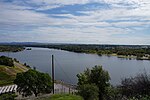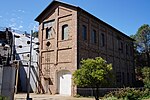Orangevale, California
Census-designated places in CaliforniaCensus-designated places in Sacramento County, California

Orangevale is a census-designated place (CDP) in Sacramento County, California, United States. It is part of the Sacramento–Arden-Arcade–Roseville Metropolitan Statistical Area. The population was 33,960 at the 2010 census, up from 26,705 at the 2000 census. It is located approximately 25 miles (40 km) northeast of Sacramento. The community is known for its rolling hills that offer the best views of the Sierra Nevada mountain range, its foothills, and a rural environment in the middle of a growing metropolitan area. Some residential properties in the area are zoned to accommodate horses and orchards. It has a ZIP Code of 95662.
Excerpt from the Wikipedia article Orangevale, California (License: CC BY-SA 3.0, Authors, Images).Orangevale, California
Orangevale Avenue, Folsom Orangevale
Geographical coordinates (GPS) Address Nearby Places Show on map
Geographical coordinates (GPS)
| Latitude | Longitude |
|---|---|
| N 38.681944444444 ° | E -121.21388888889 ° |
Address
Orangevale Avenue 9161
95662 Folsom, Orangevale
California, United States
Open on Google Maps







